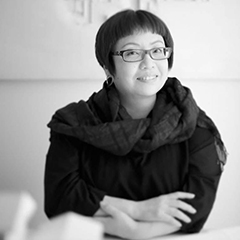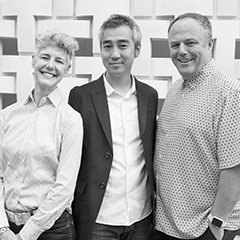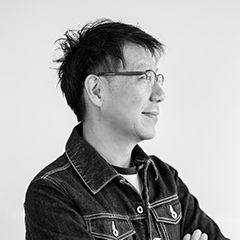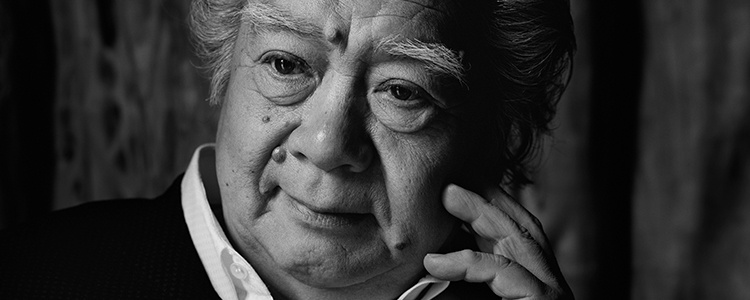Creating
Value.
Co-creators who shape their visions and transform them into value.
Vol.5
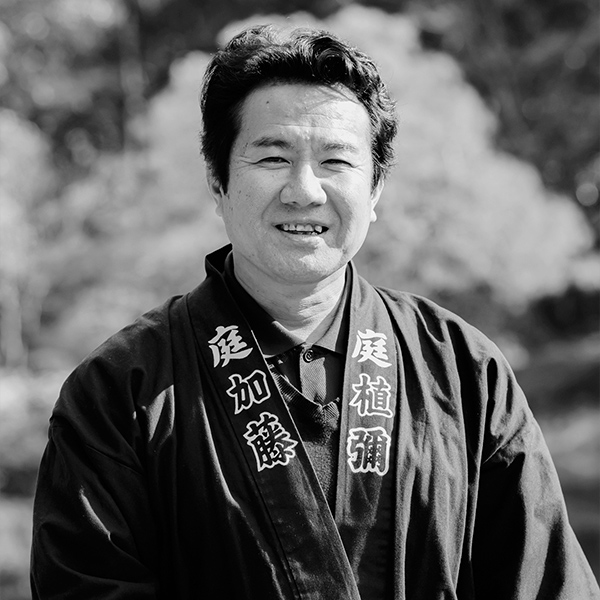
Tomoki Kato
Tomoki Kato, Ph.D.
President, UEYAKATO LANDSCAPE Co., LTD.
Professor, Kyoto University of Art and Design
There is no such thing as “completion” in gardens.
Therein lies their appeal.
Through generations since its founding in 1848 as the designated gardener of Nanzenji Temple, the head temple of the Rinzai sect of Buddhism, Ueyakato has engaged in landscape gardening from its base in Shishigatani in Sakyo-ku, Kyoto. In addition to temples and vacation homes, Ueyakato has attended to the landscapes of hotels, commercial facilities, and parks. We spoke with company president Tomoki Kato about his aesthetics and philosophy on garden landscaping. Shakkei (borrowed landscape) and saho (methodology) are some of the concepts through which we will attempt to glimpse the unique value systems of Japan.
A Japanese garden is to be cherished through the ages.
Creating a garden is not something which can be done in a day. If someone asks us to create a garden, then the relationship between that person and us, mediated by the garden, will be for the very long term. First of all, if the land in question had no garden there previously, we will begin by surveying the land to consider what kind of garden can be made there. We then plan the schedule and content, create the design, and work out all of the minute details before we finally go into the actual work. And even once it is done, that does not mean it is ever complete; rather, it marks the beginning of the garden. Our role includes managing and fostering the garden. Once created, a garden is cherished for a very long time. Since our founding about 170 years ago, as the dedicated gardener for the Buddhist Rinzai sect head temple Nanzenji, we have taken care of the temple’s gardens. The relationship goes back to my ancestors, so it’s a very long one, but the garden of Nanzenji was already there 170 years ago. And given that the Nanzen-in garden was made in the Kamakura period (12th-13th century), we can say the garden is overwhelmingly our senior.
Although the Japanese garden forms the basis of our practice, our work spans a wide range. We handle many types of gardens, not only of temples but also of hotels, cultural properties such as public spaces, and parks. Gardens are fostered over many years, yet change their way of existence in alignment with the lives of people in each era, hence the diversity of forms in the context of society.
I would now like to discuss exactly what a Japanese garden is, from my experience with a wide range of assignments. A Japanese garden is, by definition, a garden in Japan, which would mean it is unique to Japan, a culture not possible except in Japan. Its most prominent feature might be the emphasis on the “personality” of that particular garden. I would say that this degree of obsessive fixation on the distinct personality of the garden is a point of interest unique to Japanese gardens and not seen in other countries.
Certain gardens are designated by the Ministry of Education, Culture, Sports, Science, and Technology as “meisho (places of scenic beauty)” and considered especially valuable under the Law for Protection of Cultural Properties. This Murin-an (where the interview took place) is one of them. Gardens designated as cultural properties have a reason for their designation, that is, a specific cultural value. When entrusted with such a garden, we are charged with the responsibility of handing down the garden’s distinctive character to future generations. It is not just designated cultural properties which have distinct personalities; every garden does, just like people do. Although they may all fall into the same category of “Japanese gardens,” their personalities are a fruition of the will of the people of the past who created and fostered that garden. It is one of our pleasures to connect with the radiance of the garden’s personality.

Shakkei (borrowed landscapes) are found in outstanding gardens.
I mentioned the importance of personality. What, then, is the personality of a garden? First and foremost, there are the elements of geology, topography, and climate. Also of importance are regional and historical elements. These elements interact to gradually form the “locality” of the place, that is, the personality. For instance, in the Higashiyama/Nanzenji area of Kyoto, there are many gardens which symbolize the modernization of Kyoto, including Murin-an. This area is where the Lake Biwa Canal was constructed to promote modern industry in the Meiji period at the end of the 19th century. When the Canal began delivering abundant quantities of water, a slew of gardens were created incorporating that water. So the historical and regional context is appreciated as the value of the garden.
Another distinctive concept in Japanese gardens is the shakkei, or borrowed landscape. This is a technique whereby the outer scenery is incorporated as part of the garden. This concept seems to have existed among the Japanese as early as the medieval Heian period. Tachibana no Toshitsuna, who is said to have written Japan’s oldest gardening document “Sakuteiki (On the Creating of Gardens),” had an interesting conversation with the retired emperor Shirakawa. The latter, who had just finished building Toba Rikyu Imperial Villa, asked the former which garden he thought was the best. Needless to say the retired emperor had hoped the gardening expert would praise his Toba villa; however, Tachibana named another garden and did not consider the one in Toba Rikyu to be the best in the era. This was because in Tachibana’s mind, the garden did not exist in isolation; a good garden was one whose topography and panoramic view were also outstanding.
Do you know about the Emperor Gomizunoo, who reigned in the early Edo period in the mid-17th century? He is the one who built the famous Shugakuin Rikyu Imperial Villa. Having searched throughout Kyoto to find the best place to build his villa, he settled on Shugakuin Rikyu because of the excellent view it afforded. The bird’s eye view from the Upper Tea House is absolutely breathtaking, even today. As this episode indicates, the sensibility of considering a garden not in terms of itself but as the entire land encompassing the garden seems to run strongly in the Japanese DNA.
Yoshiharu Hoshino (CEO of Hoshino Resorts) also discovered Hoshinoya Kyoto in the land of Arashiyama. When we were entrusted with this ryokan’s garden, we mulled over what kind of garden should be born of this land, and how it should be fostered once created. Even though we had fun with the unique gimmick of arriving by boat, our focus was not solely on Hoshinoya Kyoto, but on a garden that would be worthy of this land, which includes the singular scenic beauty of Arashiyama itself. A traveler’s time at a lodging facility is short. The garden must always have something to offer regardless of when a guest may visit. Morning, noon, evening, night; spring, summer, autumn, winter; rain, shine, cloudy, snowy; flowers, birds, wind, moon. These elements combine to comprise the “face of the garden” in at least 256 different ways. A garden which offers once-in-a-lifetime encounters will mean the guest will never tire of visiting again and again.
One of the things we were careful to retain in fostering the garden of Hoshinoya Kyoto was the “gardener’s presence.” Usually, hotels and ryokans have a designated housekeeping time slot, outside of which guests will not see these activities taking place. The rooms are cleaned and prepared in a flurry of frenetic activity in the absence of occupants, and come check-in time, the staff will change into neat uniforms to welcome the guests. This procedure is a given in the entire lodging industry. But Japanese gardens are not like that. In the past, householders would make a point of summoning the gardener when guests were visiting. The idea was to treat the guests to the clip-clip of pruning shears in the midst of birdsong. Today, this custom has all but disappeared. It’s a shame that most people seem to think the presence of gardeners would interfere with the enjoyment of scenery.
At Hoshinoya Kyoto, the gardener can be seen living in harmony with the garden. His bearing is one of time-honored beauty, blending with the scenery and creating a milieu of traditional elegance as he cleans and tends to the garden. Obviously, if his skill level was pathetic he would be an eyesore, but a professional gardener goes about his tasks with refined movements. In a way, it is like Sado, the Way of Tea. After all, isn’t the tea ceremony as much about enjoying the act of making the tea as it is about drinking it?

A garden is never “completed.”
A decade has passed since Hoshinoya Kyoto was created. The bamboo, which at first looked rather uptight, is now more pleasantly relaxed. Although we had our share of tribulations, such as when wild monkeys ate up our painstakingly cultivated bamboo shoots, it fills my heart to see the garden as it is today.
For the garden, there is no such concept as completion. A painting is completed when the painter puts down the brush, and a building likewise has its moment of completion. In architecture, there is the concept of repair, in which faded walls must be repainted to restore them to their original color. European gardens are also governed by this principle of restoring to the original state, so they are manicured to maintain a designated shape. But in the Japanese garden, caretaking of shrubs and trees is not a simple matter at all; it is not just about pruning overgrown branches. They must be fostered to be better with each coming year. The garden of Hoshinoya Kyoto is also sure to grow more and more appealing going forward.
Japanese gardens are attracting worldwide attention, and must continue their evolution over the long term. But they face a major challenge: the dwindling numbers of gardeners. Today, convenience stores offer everything you need, and every household has access to hot water at the turn of the faucet. It’s convenient, but this backdrop is leading to a devastating decline in gardeners’ skill. In the past, children ran around the woods in their shorts and swam naked in the rivers. Even without the aid of reference books, they knew from experience which kinds of trees grew where. Children nowadays have very few opportunities to come into contact with nature. Most houses don’t have yards or gardens anymore. Gardens are no longer something to own and cherish, but somewhere public to visit, like biotopes in grade schools. But we cannot sit on our hands lamenting the loss. We are in the process of exploring positive ways of addressing this situation.
The gardener’s outlook on nature and scenery must allow for moments where images flit by in the mind, as illustrated in the song, Oborozuki-yo (“Hazy Moonlit Spring Night”): “The spring breeze lifts my eyes to the sky/To the evening moon and gentle scent nearby.” Of course I am not saying my colleagues and I understand everything about plants. After all, our work entails imagining something we have never seen, such as what a garden might have looked like 500 years ago. But if we are to retain the culture of the Japanese garden going forward, and foster beautiful gardens, then our task is to increase the opportunities for us to come into contact with nature and understand the diversity of its interpretation.

Profile
Born in Kyoto in 1966. Graduated from Chiba University Faculty of Horticulture Department of Horticultural Economics. Joined Ueyakato Landscape Co., Ltd. to take on the family business. Became president in 2005. Received the Japanese Institute of Landscape Architecture Award (research paper category) in 2013 and the Japan ICOMOS Award in 2018. Has engaged in numerous gardens designated as National Sites of Scenic Beauty and gardens of temples in Kyoto.
- Major works
- Nanzenji, Shosei-en (Higashi Honganji), Chishaku-in, Shiun no Niwa (Konkai Komyoji), Hoshinoya Kyoto, Hoshinoya Tokyo

